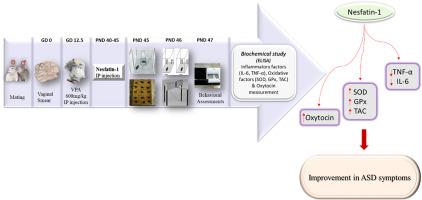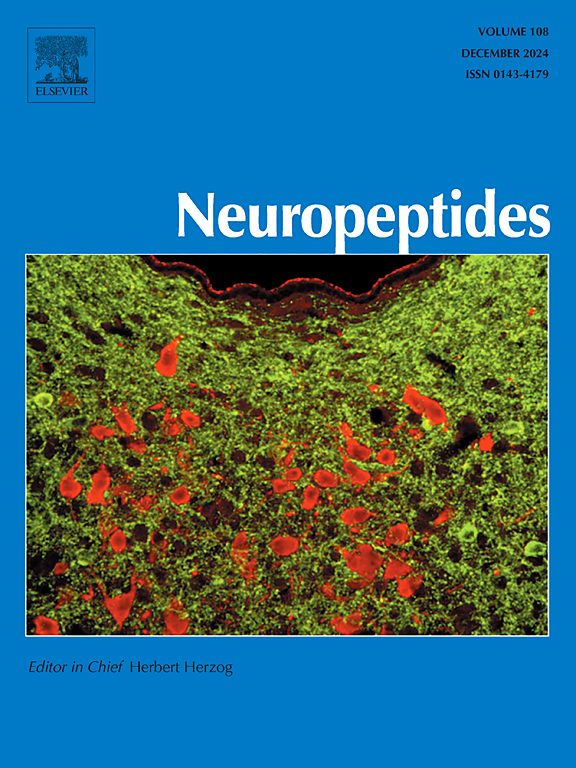在产前丙戊酸诱导的自闭症大鼠模型中,Nesfatin1通过抗氧化、抗炎活性减弱自闭症样行为
IF 2.7
3区 医学
Q3 ENDOCRINOLOGY & METABOLISM
引用次数: 0
摘要
Nesfatin1是一种参与能量稳态和神经调节的多功能肽,已成为调节神经发育障碍的有希望的候选者。Nesfatin1在中枢神经系统(CNS)中已被证实具有抗炎、抗氧化和神经保护特性。因此,它已成为多种神经系统疾病靶向治疗的候选药物。自闭症谱系障碍(ASD)是一种重要的神经系统疾病。考虑到nefatin1所证明的这些机制的重要性,本研究旨在探讨Nesfatin1在自闭症大鼠模型中的治疗潜力和机制。本研究评估了Nesfatin1在产前暴露于丙戊酸(VPA)诱导的自闭症啮齿动物模型中的治疗潜力。怀孕的Wistar大鼠在胚胎期第12.5天接受了VPA治疗,随后通过三室社会互动测试、弹珠掩埋、穿梭箱被动回避和高架迷宫等一系列综合测试来评估雄性后代的自闭症样行为。行为学测试后,对大鼠实施安乐死,经心肌灌注取血。检测血清催产素水平,ELISA法检测海马组织炎症标志物(IL-6、TNF-α)。测定总抗氧化能力(TAC)、谷胱甘肽过氧化物酶(GPx)和超氧化物歧化酶(SOD)活性。暴露于vpa的大鼠表现出明显的社交缺陷,重复性行为增加,认知能力受损,并伴有神经炎症和氧化应激升高。值得注意的是,Nesfatin1治疗显著改善了社会参与和偏好,减少了焦虑和重复行为,并将生化参数恢复到正常水平。结果表明,Nefastin1可能的治疗机制是通过降低炎症和氧化应激标志物,同时提高催产素水平,以及其他未知的机制。本文章由计算机程序翻译,如有差异,请以英文原文为准。

Nesfatin1 attenuates autism-like behavior via antioxidant, anti-inflammatory activities in a prenatal valproic acid-induced rat model of autism
Nesfatin1, a multifunctional peptide involved in energy homeostasis and neural regulation, has emerged as a promising candidate for modulating neurodevelopmental disorders. The anti-inflammatory, antioxidant, and neuroprotective properties of Nesfatin1 have been proven in the central nervous system (CNS). Therefore, it has emerged as a candidate for targeted therapy of various neurological condition. Autism Spectrum Disorder (ASD) is a significant neurological disorder. Considering the importance of these mechanisms demonstrated by Nefastine1, The current study aimed to investigate the therapeutic potential and mechanisms of Nesfatin1 in a rat model of autism. This study evaluated the therapeutic potential of Nesfatin1 in a rodent model of autism induced by prenatal exposure to valproic acid (VPA). Pregnant Wistar rats received VPA on embryonic day 12.5, and male offspring were subsequently assessed for autism-like behaviors using a comprehensive battery of tests, including the three-chamber social interaction test, marble burying, shuttle box passive avoidance, and the elevated plus maze. Following behavioral testing, rats were euthanized, and blood samples were collected via transcardial perfusion. Serum oxytocin levels were measured, and hippocampal tissues were analyzed for inflammatory markers (IL-6, TNF-α) using ELISA. Additionally, total antioxidant capacity (TAC) and the activities of glutathione peroxidase (GPx) and superoxide dismutase (SOD) were assessed. VPA-exposed rats exhibited significant social deficits, increased repetitive behaviors, and impaired cognitive performance, accompanied by heightened neuroinflammation and oxidative stress. Notably, treatment with Nesfatin1 markedly improved social engagement and preference, reduced anxiety and repetitive behaviors, and restored biochemical parameters toward normal levels. Results showed that possible therapeutic mechanism of Nefastin1 are by decreasing inflammation and reducing markers of oxidative stress, while concurrently elevating levels of oxytocin, in addition to the other unknown mechanisms.
求助全文
通过发布文献求助,成功后即可免费获取论文全文。
去求助
来源期刊

Neuropeptides
医学-内分泌学与代谢
CiteScore
5.40
自引率
6.90%
发文量
55
审稿时长
>12 weeks
期刊介绍:
The aim of Neuropeptides is the rapid publication of original research and review articles, dealing with the structure, distribution, actions and functions of peptides in the central and peripheral nervous systems. The explosion of research activity in this field has led to the identification of numerous naturally occurring endogenous peptides which act as neurotransmitters, neuromodulators, or trophic factors, to mediate nervous system functions. Increasing numbers of non-peptide ligands of neuropeptide receptors have been developed, which act as agonists or antagonists in peptidergic systems.
The journal provides a unique opportunity of integrating the many disciplines involved in all neuropeptide research. The journal publishes articles on all aspects of the neuropeptide field, with particular emphasis on gene regulation of peptide expression, peptide receptor subtypes, transgenic and knockout mice with mutations in genes for neuropeptides and peptide receptors, neuroanatomy, physiology, behaviour, neurotrophic factors, preclinical drug evaluation, clinical studies, and clinical trials.
 求助内容:
求助内容: 应助结果提醒方式:
应助结果提醒方式:


